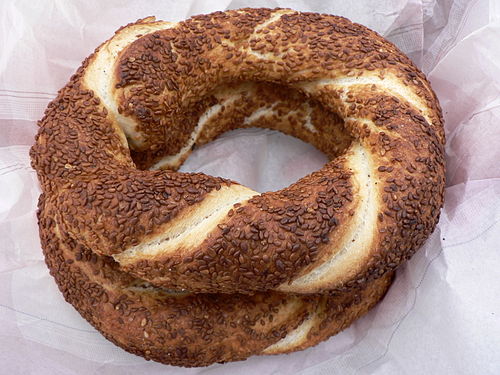 | |
| Alternative names | rosquilla (France, Spain), bokegh (Armenia), Đevrek (Bosnia, Serbia), koulouri (Greece), covrig (Romania), gevrek (Bulgaria and North Macedonia), and Turkish bagel (United States) |
|---|---|
| Type | Bread |
| Place of origin | Ottoman Empire[1] Roman Empire[2][3] |
| Main ingredients | Dough (flour, water, yeast, salt),[citation needed]sesame seeds |
| Variations | Also called Shureik, Ka'ak, and Sameet[citation needed] |
Simit is a circularbread, typicallyencrusted withsesame seeds or, less commonly, poppy,flax or sunflower seeds, found across thecuisines of the former Ottoman Empire and theMiddle East, especially in Armenia, Turkey and the Balkans.[4] Simit's size, crunch, chewiness, and other characteristics vary slightly by region.
Inİzmir, simit is known asgevrek ("crisp"), although it is very similar to theIstanbul variety. Simit inAnkara are smaller and crisper than those of other cities.[citation needed]


The wordsimit comes fromArabicsamīd (سميد) "white bread" or "fine flour".[5][6]
Other names are based on the Byzantine Greekkollikion (κολλίκιον), or Ancient Greekkollyra (κολλύρα), or Greekkoulouri (κουλούρι). InLatin it is known asarculata.Aramaic: ܩܶܠܽܘܪܳܐ/ܩܸܠܘܿܪܵܐ (qeluro/qelora); Turkish:gevrek;[7][8]South Slavicđevrek, ђеврек,gjevrek, ѓеврек, геврек. TheArmenian name isբոկեղ (bokegh). InJudaeo-Spanish it is known asroskas turkas.[9] InEnglish it is known asTurkish bagels,rosca orcoulouri.[10]
Archival sources show thatsimit has been produced inIstanbul since 1525.[11] Based onÜsküdar court records (Şer’iyye Sicili) dated 1593,[12] the weight and price of simit was standardized for the first time. The 17th-century travelerEvliya Çelebi wrote that there were 70 simit bakeries in Istanbul during the 1630s.[13] Jean Brindesi's early 19th-century oil paintings about Istanbul daily life show simit sellers on the streets.[14]Warwick Goble, too, made an illustration of these simit sellers of Istanbul in 1906.[15] Simit and its variants became popular across the Ottoman Empire.[citation needed]


Simit is generally served plain, or forbreakfast with tea,fruit preserves, orcheese orayran. Drinkingtea with simit is traditional. Simit ("Bokegh" in Armenian) is a traditional Christmas bread in Armenia.[citation needed]
Simit are generally sold bystreet vendors in Turkey,[16] who either have a simit trolley or carry the simit in a tray on their head. Street merchants generally advertise simit as fresh ("Taze simit!"/"Taze gevrek!")[17] since they are baked throughout the day; otherwise hot ("Sıcak, sıcak!") and extremely hot ("El yakıyor!" means "It burns the hand!") when they are not long out of the oven.[citation needed]
Simit is an important symbol for lower and middle-class people of Turkey. Sometimes it is calledsusam kebabı ("sesamekebab").[citation needed]
In other parts of the Middle East, in Egypt it is consumed with boiled eggs and/orduggah, which is a mixture of herbs used as condiments. It is commonly used to break the fast, with yoghurt or buttermilk, in mosques inMecca andMedina.[citation needed]
Today, many municipalities in Turkey produce simit through their own subsidiaries.[18]
Certain varieties of Romaniancovrigi are similar to simit, the places that sell them even being known assimigerii.
Another type of bread similar to simit is known asobwarzanek (in particularobwarzanek krakowski) in Poland andbublik in Russia, Ukraine and Belarus. The main difference is that the rings of dough are poached briefly in boiling water prior to baking (similarly tobagels), instead of being dipped in water and molasses syrup, as is the case with simit.[citation needed]
Girde (Uygur: Гирде) is a type of bread baked on the walls of tandoori oven, that is very similar to simit, and that theUyghurs inChina see as a characteristic item in their culture-specific kitchen.[citation needed]